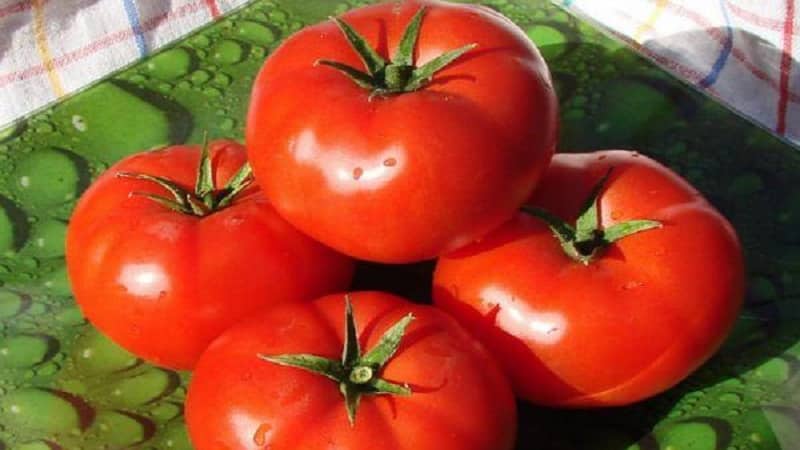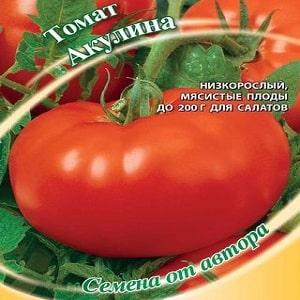A large-fruited variety with a pleasant taste - the Akulina tomato and a step-by-step guide to growing it
The Akulina variety is one of the unpretentious low-growing tomatoes for cultivation in open ground and under film covers. The small height of the bushes, only 80 cm, allows you to grow the plant on the balcony in garden pots.
In this article we will talk about the principles of agricultural technology, the advantages and disadvantages of the variety, and the use of tomatoes in cooking.
Description of the variety
The Akulina tomato is an early-ripening variety bred by biologists of the Research Institute for Breeding Vegetable Crops and the Gavrish Agrofirm. The variety was included in the State Register of Russia in 2011. The culture is intended for cultivation in film greenhouses and in open ground.
Determinant bushes with a limited growth point reach 80 cm in height and do not require pinching or shaping. Clusters of fruit are tied to wooden stakes for support.
The photo shows the fruits of the Akulina variety.

The table shows its main characteristics.
| Indicators | Characteristic |
| Weight | 180-200 g |
| Form | Round, with slight ribbing |
| Coloring | Unripe fruits are green without a dark spot, ripe ones are red. |
| Leaves | Medium size, light green color |
| Inflorescence | Simple |
| Pulp | Dense, juicy |
| Taste | Sweet |
| Skin | Dense, shiny, does not crack |
| Number of slots | 4-6 |
| peduncle | With articulation |
| Purpose | For fresh consumption |
| Ripening period | 110-118 days after germination |
| Productivity | In closed ground - up to 6 kg per bush, in open ground - 3-5 kg |
| Sustainability | Tobacco mosaic virus, fusarium, verticillium |
| Transportability | High |
How to grow seedlings
The Akulina tomato is grown using the seedling method. Sowing is carried out in the last ten days of February - the first ten days of March, 50-60 days before transferring to a permanent place.
Seed preparation
Varietal seeds need to be disinfected and soaked in germination stimulants. This rule especially applies to seeds collected by hand from previously grown tomatoes.
To begin with, the seed material is soaked for 10 minutes in a saline solution (1 tsp per 250 ml of water). Empty grains, unsuitable for germination, rise to the surface. High-quality material remains at the bottom of the glass. These seeds are washed with warm running water and poured with a slightly pink solution of potassium permanganate for 30-60 minutes.
To protect seeds from mold and rot, use the drug “Baikal EM” (5 drops of liquid per 200 ml of settled water). The seeds are wrapped in gauze and immersed in the solution. The holding time is two hours. The seeds are not washed, dried on a napkin and sown.
To speed up germination, seeds are treated with the preparations “Radifarm”, “Epin Extra”, “Heteroauxin”, “Biostim”.
Container and soil
Seedlings are grown in fertile and loose soil. For this purpose, a ready-made substrate from the store or a mixture prepared at home is suitable. In a large bucket, mix 70% earth, 15% river sand, wood ash or peat, 15% humus.
Plastic trays, containers, and seedling cassettes are suitable as containers. Drainage holes are made in the bottom to drain excess water.
In practice, the second method of growing seedlings is often used - without picking.Seeds are sown in individual plastic or peat cups with a volume of 300 ml.
Advantages of the method:
- no need for transplantation;
- seedlings do not experience unnecessary stress;
- a strong root system is formed;
- there is no risk of infection spreading to neighboring seedlings.
Before sowing, the soil and containers are disinfected in the oven, microwave, steamer, or treated with Fitosporin. After this, the soil is watered and left for two weeks.
Sowing
Containers are filled 2/3 with prepared soil and lightly compacted. The seeds are laid out to a depth of 1.5 cm at a distance of 2 cm. Watered with a syringe and covered with polyethylene to create a greenhouse effect. The containers are moved to a warm place without direct sunlight.
Growing and care
When the first shoots appear, the containers are placed on a sunny windowsill. Daylight hours are at least 16 hours. If there is a lack of lighting, the seedlings are illuminated with a phytolamp.
Watering – moderate, 2-3 times every 10 days, after the top layer has dried. The sprouts are sprayed with a spray bottle once a week.
Sentsy is taken out to the balcony for 15-30 minutes, when the average daytime temperature reaches +10 °C. The hardening procedure increases resistance to temperature changes in open ground or under film cover.
Before the seedlings are transferred to the soil, a double application is carried out. feeding mineral complexes.
For the first feeding, dissolve in 1 liter of water:
- urea – 0.5 g;
- potassium salt – 1.5 g;
- superphosphate – 4 g.
For the second feeding, dissolve in 1 liter of water:
- superphosphate – 4 g;
- ammonium nitrate – 0.6 g;
- potassium sulfate – 2 g.
The break between feedings is 2-3 weeks.
Agricultural technology of tomatoes
The rules for cultivating the Akulina variety are not particularly complicated. The bushes do not need pinching or shaping. Plants prefer moderate watering in combination with soil mulching and the application of organic and mineral fertilizers.
Landing
Seedlings are planted in prepared soil:
- in the fall, remove the remains of plants and dig up the ground;
- fertilize with humus (10 l per 1 m²);
- in the spring, the ground is dug up again and fed with humus (10 liters per 1 m²);
- the soil is disinfected with a strong solution of potassium permanganate or a 0.5% solution of copper sulfate (50 g/10 l).
To plant bushes, choose a site on the south side, without drafts. Tomatoes grow best in light, sandy loam soil. The holes are prepared in advance - dug at a depth of 20 cm and filled with boiling water.
Seedlings are planted according to a 40x50 cm pattern, 4-5 bushes per 1 m². Garter stakes are dug in nearby.
Advice. To get a high yield, plant tomatoes in the area where you previously grew zucchini, cabbage, dill, parsley, onions, and carrots.
Care
Rules for caring for Akulina tomatoes:
- Moderate watering with warm settled or rain water at the root - 1-2 times a week, or installing drip irrigation.

- Regular loosening and weeding of beds to remove weeds.
- Mulching with straw, peat, pine needles, sawdust.
- Removing dry and yellowed leaves.
Tomatoes are fertilized at least twice during the entire growing season:
- A week after planting in the ground, to stimulate growth, the plants are watered with a urea solution (5 g/10 l per 1 m²).
- During flowering and formation of ovaries - azofoska solution (10 g/10 l per 1 m²).
Ready-made organic fertilizers (Pixa, Virmix) and mineral fertilizers (Kemira, Mortar) are especially popular among gardeners.The products have a balanced composition, eliminating the need to mix the components yourself. The packaging indicates the proportions and frequency of their use.
Diseases and pests
The Akulina variety is immune to fusarium wilt and verticillium at the genetic level. Farmers note the resistance of tomatoes to cladosporiosis And late blight.
However, preventive measures will not hurt:
- compliance with crop rotation rules;
- regular ventilation of greenhouses;
- soil treatment with copper sulfate;
- disinfection of seeds in a solution of potassium permanganate;
- normalization of humidity in the greenhouse;
- compliance with watering standards;
- mulching the soil with straw, sawdust, pine needles, agrofibre;
- removing the lower leaves;
- treatment (twice a month) with the preparations “Integral”, “Fitosporin M”.
Tomato bushes are most often attacked by the Colorado potato beetle, spider mite, and whitefly. The following insecticides are most effective: “Decis Profi”, “Strela”, “Confidor”, “Flumite”, “Borneo”, “Fitoverm”, “Iskra”.
To combat the gnawing cutworm use:
- biological agent "Lepidocid";
- universal contact preparation “Decis Expert”;
- insecticide "Proclam".
Folk remedies against insect pests:
- infusion of garlic arrows (400 g of raw material, pour 3 liters of water, leave for five days, filter and add 50 g of soap shavings);
- wormwood decoction (600 g of herb is poured into 5 liters of boiling water, left for 3-4 days and the concentrate is diluted with water in a ratio of 1:10);
- universal infusion (50 g of celandine, 70 g of tobacco shag, 50 g of wormwood, 150 g of chopped garlic, pour 10 liters of boiling water, leave for 25 hours, then mix in 25 g of laundry soap shavings).
Reference. Folk remedies are used to spray plants every two weeks.
The nuances of growing in open ground and in a greenhouse
In Russia, the Akulina tomato is cultivated almost everywhere:
- in the southern regions of the country the crop is grown in open ground;
- in the middle zone - under film covers or in greenhouses without heating;
- in the north - in heated glass greenhouses.
Due to its short stature and early ripening, the variety is grown on balconies in large pots.
There are no particular differences in plant care depending on where they grow. A garter is used for all growing methods so that the stems do not break and the fruits do not come into contact with the ground.
When cultivating in a greenhouse or balcony, the room is regularly ventilated and the humidity level is controlled.
Harvesting and application
The fruits begin to be harvested at the stage of full ripeness at the end of July. Due to their high sugar content, tomatoes have excellent taste and are suitable for preparing salads, appetizers, sauces, pasta, juice, soups, and vegetable caviar. The thick skin does not crack when treated with hot marinades, which makes it possible to preserve tomatoes.
Tomatoes are distinguished by their keeping quality and retain their presentation when stored in the cellar for up to 20 days. You can extend the shelf life by collecting the fruits along with the stalk.
Advantages and disadvantages
Advantages of the variety:
- high productivity;
- wonderful taste;
- resistance to major tomato diseases;
- ease of care;
- possibility of transportation over long distances;
- keeping quality;
- universal use in cooking;
- Possibility of growing in the garden and greenhouse.
Flaws:
- need for garter;
- when grown in regions with cold climates, it needs shelter.
Reviews
Reviews from gardeners about the Akulina variety are mostly positive.
Alla, Krasnodar: “The variety is disease-resistant and does not require special care. Low-growing bushes do not need pinching. I only tie up fruit clusters. The tomato ripens early and has high yields.”
Alevtina, Roslavl: “Growing tomatoes is not difficult, and the yield is always pleasing. The fruits are large, bright red, slightly ribbed. The taste is sweet. The pulp is fleshy and juicy, ideal for fresh salads.”
Alexander, Liski: “I got acquainted with the variety last year. We have never had such juicy and meaty tomatoes. We use the fruits for winter preparations, cook tomato sauce and lecho. It’s easy to care for plants, just water and feed them moderately.”
Conclusion
Akulina tomatoes are distinguished by their unpretentiousness in care: young shoots do not need to be removed, only brushes dotted with fruits are tied to the stakes, the plants are watered 1-2 times a week and fed with nitrogen, potassium and phosphorus.
The plant is immune to viral diseases, and frequent loosening of the soil, removal of weeds, mulching and periodic treatments with Fitosporin and Integral help prevent infection by bacteria and fungi. Universal use in cooking makes it possible to enjoy the excellent taste of fresh tomatoes and prepare them for the winter.